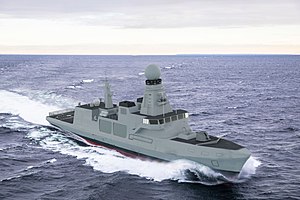European Patrol Corvette

| |
| Class overview | |
|---|---|
| In commission | Projected from 2030 |
| General characteristics | |
| Type | Corvette |
| Displacement | <3,000 t[1] |
| Length | <110 m (360 ft 11 in) |
| Draft | <5.5 m (18 ft 1 in) |
| Propulsion | CODLAD, CODAD |
| Speed | 24 knots (44 km/h; 28 mph) or 26 knots (48 km/h; 30 mph) |
| Armament | Varied depending on nation and role[2] |
| Aircraft carried | NH90-sized helicopter and/or UAVs |
European Patrol Corvette (EPC or PPX) is a Permanent Structured Cooperation (PESCO) project that was adopted by the European Council on 12 November 2019. The objective is to design and develop a new class of warship. The project is coordinated by Italy, with France, Spain and Greece participating and Portugal as an observer.[3][2] In December 2021, it was reported that Norway and Denmark had also joined the project.[4]
The ships will have a conventional hull of different dimensions, armament and propulsion systems.
The EPC will be have at least two versions:
- Combat variant (reported Italian preference): 3D radar and combat management systems, medium/short-range surface-to-air missiles (SAM), anti-torpedo countermeasures, envisaged top speed: 25–26 knots (46–48 km/h; 29–30 mph);
- Long-range patrol variant (reported French preference): 3D radar and combat management systems, medium/short-range SAM, envisaged top speed: 24 knots (44 km/h; 28 mph)[5]
Other sources had earlier suggested that three variants were to be considered:
- EPC optimised for anti-surface (ASuW) and anti-aircraft (AAW) warfare with the possibility of anti-submarine warfare (ASW) and with self-defence capabilities
- EPC optimized for anti-surface warfare (ASuW) and designed with oceanic reach (range of 10,000 nautical miles, 19,000 km, 12,000 mi at 14 knots, 26 km/h, 16 mph).
- EPC optimized for blue-water (offshore) patrol missions[6]
Whatever the configuration and variants, as of 2022 the participating member states aim to potentially sign a contract as early as 2025 and the keel laying of the first ship to take place in 2026 and delivery starting in 2030.[1][7]
In 2022, it was indicated that the project would receive a further 200 million Euro from the European Union's defence fund (EDF).[8]
Participants
Member states:
Companies:
Expected users
 Spanish Navy
Spanish Navy
- Supplements: Serviola, Infanta Elena Classes
 French Navy
French Navy
- Supplements/Replaces: Floréal Class
See also
References
- ^ a b "EDA to support 'European Patrol Corvette' PESCO project". European Defence Agency. 4 January 2021. Retrieved 12 May 2021.
{{cite web}}: CS1 maint: url-status (link) - ^ a b "The PeSCo's European Patrol Corvette (EPC) programme gains momentum". European Defence Review. 19 October 2020. Retrieved 9 July 2021.
{{cite web}}: CS1 maint: url-status (link) - ^ "Corvette europee, i dettagli". portaledifesa.it (in Italian). Archived from the original on 17 October 2020. Retrieved 20 October 2020.
- ^ Kington, Tom (13 December 2021). "Denmark, Norway join European corvette program". Defense News. Retrieved 31 December 2021.
{{cite web}}: CS1 maint: url-status (link) - ^ Kington, Tom (3 November 2021). "Amid high hopes, can the European Patrol Corvette deliver?". Defense News. Retrieved 31 December 2021.
{{cite web}}: CS1 maint: url-status (link) - ^ "NAVIRIS and NAVANTIA sign MoU for the European Patrol Corvette Program". Naval News. 11 February 2021. Retrieved 12 February 2021.
- ^ Gain, Nathan (17 March 2022). "European Patrol Corvette Could Start Construction In Four Years". Naval News. Retrieved 17 March 2022.
- ^ "European Patrol Corvette to get fresh money from EU coffers". 9 September 2022.
